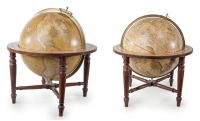
In the afternoon, Thomas Jefferson might have greeted newly arrived visitors in the Entrance Hall. The large number of guests at Monticello is suggested by the twenty-eight black-with-gold-trim Windsor chairs that were in the room to accommodate visitors while they waited to be received by their host.
Visitors To Monticello
Jefferson's daughter Martha remembered having as many as fifty overnight guests at one time in the twelve-bedroom house. After Jefferson's retirement from the presidency, guests -- including curious sightseers -- flocked to Monticello in such numbers that he designed and occasionally retreated to a second home named Poplar Forest, some seventy miles from Monticello. Overnight guests ranged from family members who stayed for weeks at a time to international figures. James and Dolley Madison visited so often that the family came to call one of the first-floor bedrooms the "Madison Room."
The Mountaintop Museum
The Entrance Hall was the only room in Monticello that guests were guaranteed to see -- and it is the first one that visitors see today. Thomas Jefferson, always eager to educate, filled the room with such a variety of natural, historic, and artistic pieces that several guests described the room as a "museum" in their letters.
The New World
Among the artifacts in the room was a sampling of Jefferson's map collection of the ancient and then-modern world; his entire grouping of maps and plans numbered more than 350. Building on this interest in the world around him, Jefferson displayed many minerals, fossils, bones, and antlers, some of them gathered on the Lewis and Clark expedition that he sponsored as president. Jefferson had a particular interest in documenting native species, in part because he wanted to refute claims made by a French scientist that life forms in the New World were inferior to those of the Old.
Jefferson instructed Lewis and Clark to study Native American cultures, recording their "language, traditions, monuments; their ordinary occupations in agriculture, fishing, hunting, war, arts . . . ; their food, clothing and domestic accommodations; and articles of commerce." Through the explorers, Jefferson issued invitations to tribal chiefs to visit him in Washington, D.C. -- some of whom did. Among the items displayed in what Jefferson called his "Indian Hall" were carved stone figures, a painted buffalo robe, an Indian map on a buffalo hide, weapons, and garments.
Arts And Politics
In addition to exploring nature, the contents of the Entrance Hall also chronicled the birth of the young nation. Artwork -- such as paintings of Biblical scenes -- illustrated moral teachings, perhaps ones that Jefferson found essential in the development of the United States. Busts of the French thinkers, Voltaire and Turgot, held a prominent place in the room, just as these men did in influencing Jefferson's ideas about government. Busts of Hamilton and Jefferson, political adversaries, were placed together, but facing one another -- Jefferson wryly explained that the two would be "opposed in death as in life." Guests at Monticello -- as recently as Vice President Al Gore -- have found humor in the fact that Jefferson's own statue is significantly larger than Hamilton's. Jefferson also displayed an engraving of the "Signing of the Declaration of Independence," and kept several printed facsimiles of the Declaration (as well as Jefferson's rough draft) in his home. Jefferson used these pieces to relate his first-hand experiences in crafting our democracy.
Aside from its collection, the Entrance Hall itself is unique. Two memorable features are the Great Clock that shows the second, minute, hour, and day of the week, and the unusual grass-green floor, suggested by the artist Gilbert Stuart.



